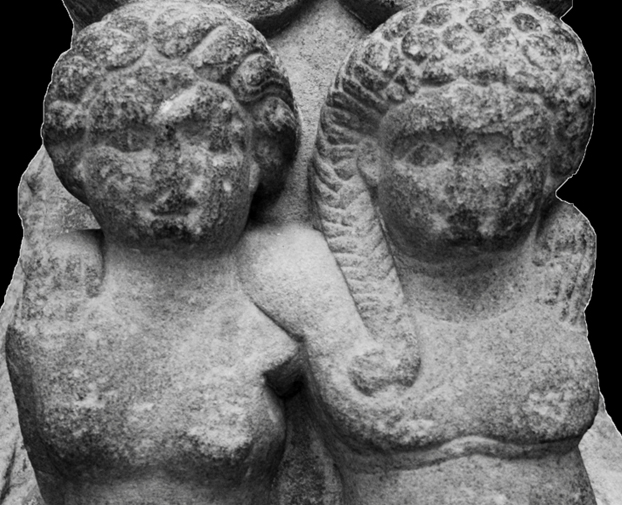Faces of Cleopatra and Antony's Twin Babies Revealed

Cleopatra's twin babies now have a face. An Italian Egyptologist has rediscovered a sculpture of Alexander Helios and Cleopatra Selene, the offspring of Mark Antony and Cleopatra VII, at the Egyptian museum in Cairo.
Discovered in 1918 near the temple of Dendera on the west bank of the Nile, the sandstone statue was acquired by the Egyptian Museum in Cairo but has remained largely overlooked.
The back of the the 33-foot sculpture, catalogued as JE 46278 at the Egyptian museum, features some engraved stars -- likely indicating that the stone was originally part of a ceiling. Overall, the rest of the statue appears to be quite unusual.
"It shows two naked children, one male and one female, of identical size standing within the coils of two snakes. Each figure has an arm over the other's shoulder, while the other hand grasps a serpent," Giuseppina Capriotti, an Egyptologist at the Italy's National Research Council, told Discovery News.
NEWS: How Cleopatra Won Her Bet
The researcher identified the children as Alexander Helios and Cleopatra Selene, Antony and Cleopatra's twins, following a detailed stylistic and iconographic analysis published by the Polish Centre of Mediterranean Archaeology at the University of Warsaw.
Capriotti noticed that the boy has a sun-disc on his head, while the girl boasts a crescent and a lunar disc. The serpents, perhaps two cobras, would also be different forms of sun and moon, she said. Both discs are decorated with the udjat-eye, also called the eye of Horus, a common symbol in Egyptian art.
Sign up for the Live Science daily newsletter now
Get the world’s most fascinating discoveries delivered straight to your inbox.
"Unfortunately the faces are not well preserved, but we can see that the boy has curly hair and a braid on the right side of the head, typical of Egyptian children. The girl's hair is arranged in a way similar to the so-called m?elonenfrisur? (?melon coiffure) an elaborated hairstyle often associated with the Ptolemaic dynasty, and Cleopatra particularly," said Capriotti.
The researcher compared the group statue with another Ptolemaic sculpture, the statue of Pakhom, governor of Dendera, now on display at the Detroit Institute of Arts, USA.
"Stylistically, the statues have several features in common. For example, the figures have round faces, little chins and big eyes," Capriotti said.

Since the statue of Pakhom was dated to 50-30 B.C., she concluded that the twin sculpture was produced by an Egyptian artist at the end of the Ptolemaic period, after Roman triumvir Mark Antony recognized his twins in 37 B.C.
The babies weren't the firsts for Cleopatra. The Queen of Egypt had already given birth in 47 B.C., when she bore Julius Caesar a child, Caesarion. In 36 B.C. she presented Antony with another son, Ptolemy Philadelphus.
At the time of their birth in 40 B.C., the twins were simply named Cleopatra and Alexander. When they were officially recognized by their father three years later, as Antony returned to Antioch, in present Turkey, and Cleopatra joined him, they were named Alexander Helios (Sun), and Cleopatra Selene (Moon).
"Antony's recognition of the children was marked by an eclipsys. Probably for this reason, and to mythologize their twin birth, the children were added those celestial names. Although in Egypt the moon was a male deity, in the sculpture the genders were reversed according to the Greek tradition," Capriotti said.
NEWS: Cleopatra Killed by Drug Cocktail?
Little is known of the children Cleopatra and Mark Antony left behind after their suicides in 30 B.C. following defeat in battle.
While Caesarion was murdered under Octavian's orders, the lives of the three offsprings of Cleopatra and Antony were spared.
Cleopatra Selene and Alexander Helios, then aged 10, and Ptolemy Philadelphus, then aged four, were moved to Rome and put under the care of Octavian's sister, Octavia whom Antony was married to.
Some years later, Alexander Helios and Ptolemy Philadelphus would disappear without a trace.
Only Cleopatra Selene survived. Married to King Juba II of Mauretania, she had at least one child, Ptolemy Philadelphus, likely named in honor of her little brother.
Her image was minted on coins along with Juba's, suggesting that she ruled as an equal partner.
"Now we have her portrayed as a child with her twin brother. Blending Egyptian myths and Greek culture, this sculpture fully represents Egypt at Cleopatra's time," Capriotti said.
This article was provided by Discovery News.









